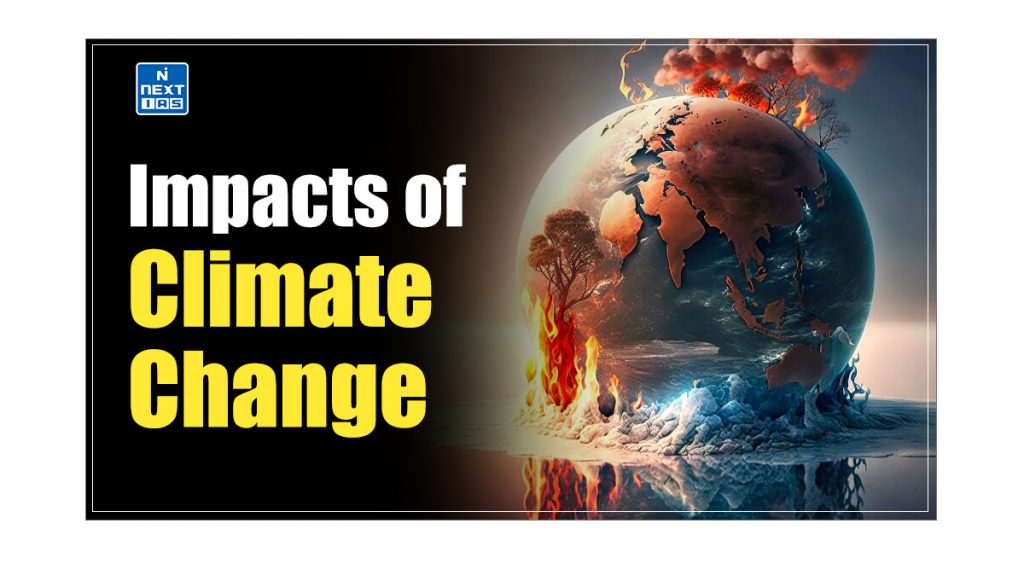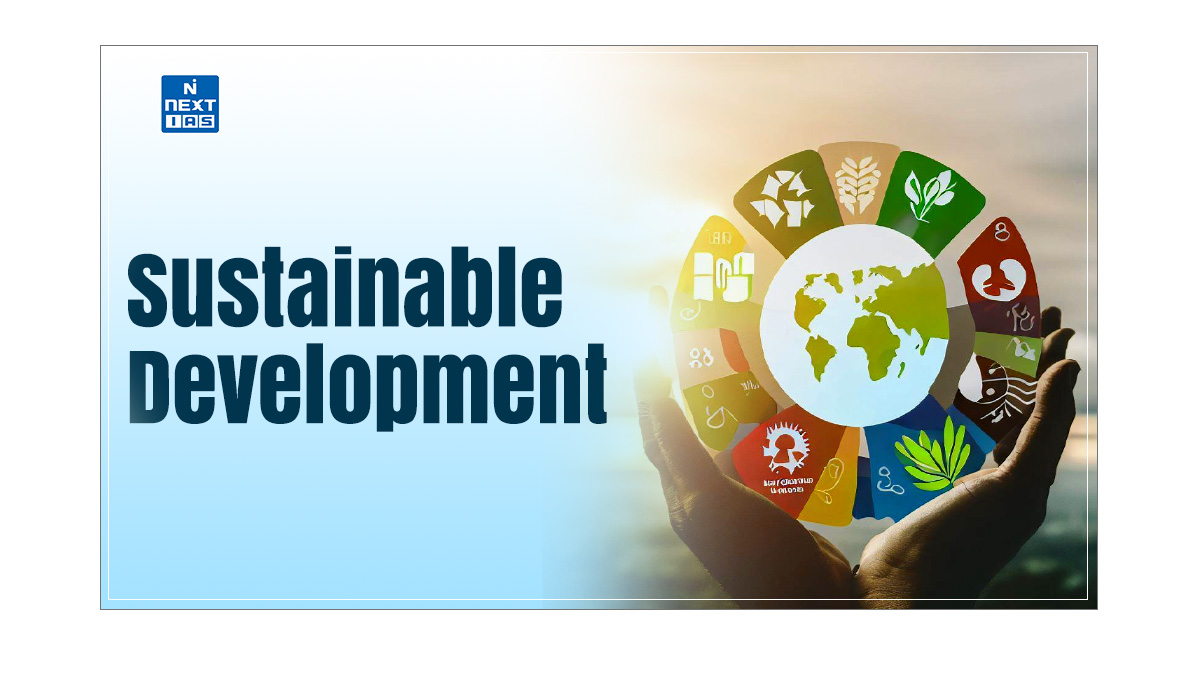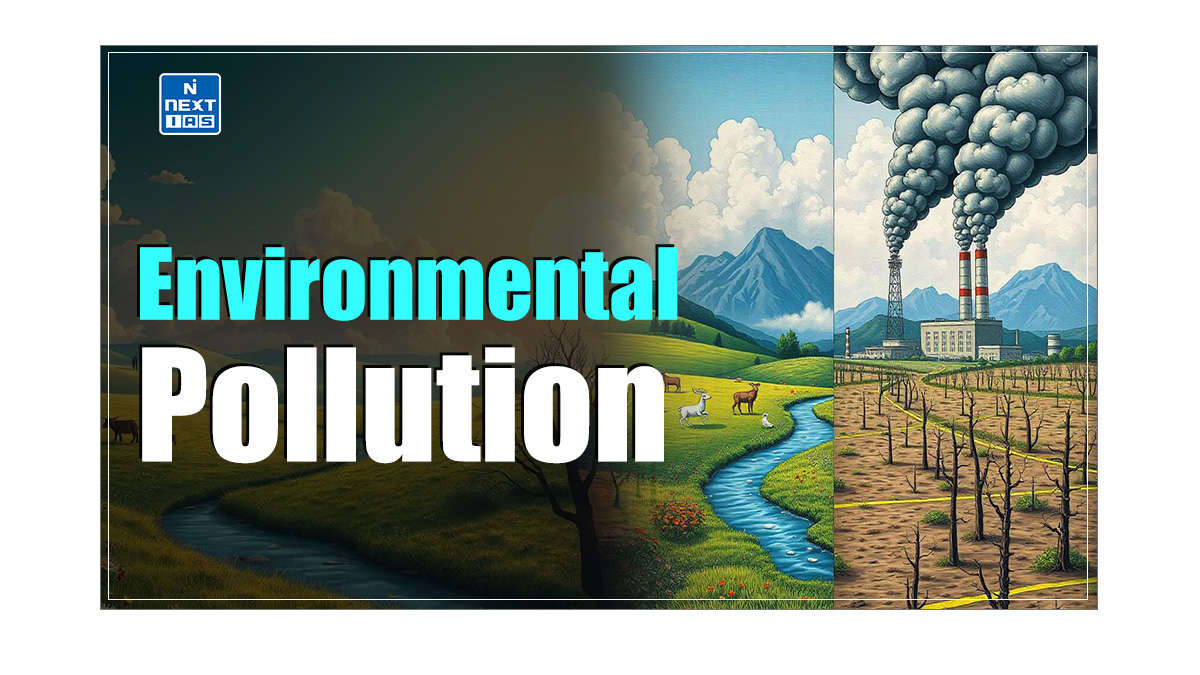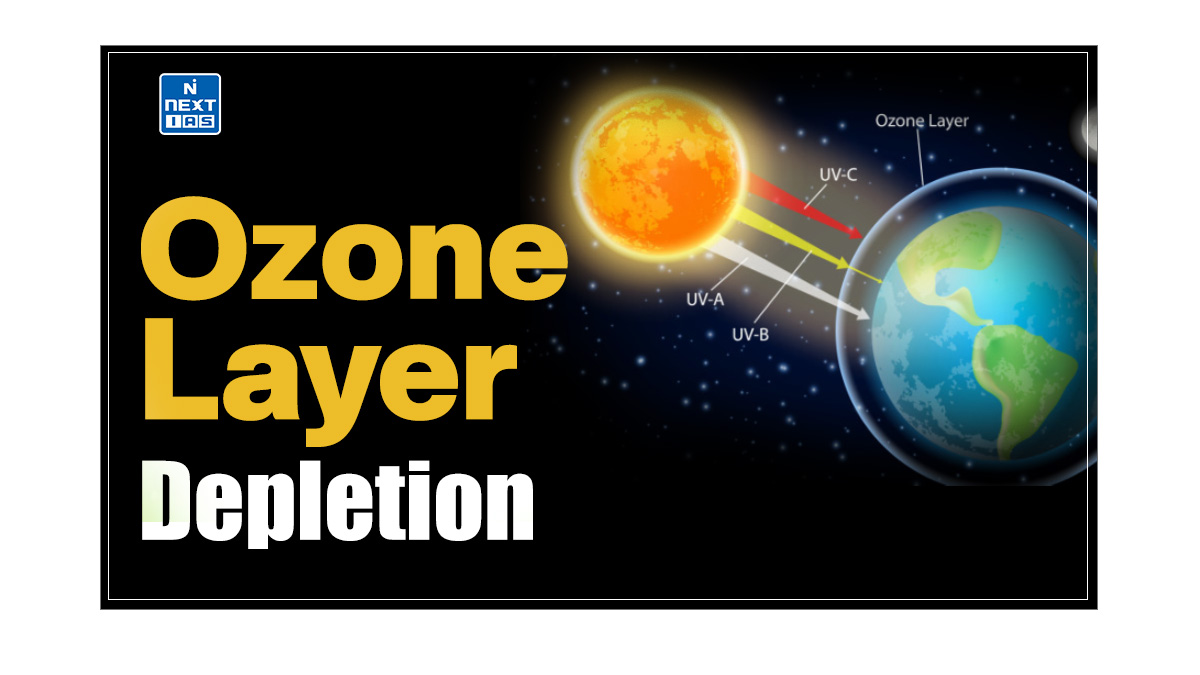
The impacts of Climate Change on India and World are widespread and varied, affecting ecosystems, economies, and human societies. India, with its vast population and diverse geography, is particularly vulnerable to the impacts of climate change. This article explores the significant impacts of climate change on India and World across multiple sectors such as agriculture & food security, water resources, ecosystem & biodiversity, health, and others.
What is Climate Change?
- Climate change means a significant change in the measures of climate, such as temperature, rainfall or wind, lasting for an extended period – decades or longer.
- It is a term that describes a long-term change in the Earth’s climate.
- The Earth’s climate has changed many times during the planet’s history, with events ranging from ice ages to long periods of warmth.
- The current warming trend is of particular significance because most extremes are likely to be the result of human activity since the mid-20th century and proceeding at a rate that is unprecedented over decades to millennia.
- Evidences reveal that current warming is occurring roughly ten times faster than the average rate of ice-age-recovery warming.
Read our detailed article on Climate Change.
Impacts of Climate Change
The impacts of climate change on India and World are multifaceted, affecting multiple sectors and areas. The same are described in detail in the sections that follow.
Impacts of Climate Change on Agriculture and Food Security
Food security is one of the leading concerns associated with climate change. Climate change affects food security in complex ways.
Global Impacts
- Climate change impacts crop yields as crop yield depends on the raw material that gets affected by the climate change.
- For example, climate change affects the availability of water for irrigation, which affects crop growth and productivity.
- It can also cause a high incidence of pest attacks.
- Even a 2°C rise in global mean temperatures by 2100 will gravely upset the current farming systems.
- Increasing uncertainty in rainfall has increased the incidences of climate change-related droughts and floods.
- With the melting of the polar ice caps due to global warming, the cultivable coastlines are bound to be inundated.
- The most impacted areas of the world will be the tropical and subtropical areas.
- The climate change impacts on livestock production are likely to be twofold:
- Firstly, the productivity losses owing to temperature increase and
- Secondly, there are changes in the availability, quality, and prices of inputs such as fodder, disease management, and water.
Impacts on India
- Most of the agriculture in India is rainfall-dependent, which will become uncertain, causing frequent droughts and floods due to climate change.
- There will be a decrease in the incidence of rainfall, which will cause a lot of desertification in India.
- The states of Rajasthan, Punjab, Gujarat, Maharashtra, Karnataka and Tamil Nadu would be affected by it the most.
- There will be a loss of arable land due to flooding because of the melting of the glaciers in India due to rising temperatures in India.
- A prominent example of this has been the constant floods in Jammu and Kashmir in the recent decade.
- The states of Uttarakhand, Uttar Pradesh, Bihar, West Bengal, Himachal Pradesh, and Northeastern will bear the brunt of such flooding of the Himalayan Glaciers.
- With constant flooding due to climate change, the top fertile layers of soil will be eroded.
- This will promote the use of fertilisers, which will not only reduce the nutritional value of food but also release greenhouse gases, which will reinforce climate change.
- The use of fertilisers will also increase the cost of crop production.
- India has a long coastline that will be impacted by rising sea levels and inundated coastal arable lands.
- This will cause a significant loss in India’s marine food system.
Impact of Climate Change on Water Resources
Global Impacts
- Climate change increases the water temperature, which, in turn, intensifies the water pollution problems and hence affects aquatic habitats negatively.
- As the water temperature increases, the biologically dissolved oxygen decreases, which impacts the marine species living in it.
- With an increase in water temperature, there is an increase in pathogens and invasive species that destroy marine ecosystems and biodiversity.
- This is found in abundance in the dying reefs in the Great Barrier Reef.
- Increasing surface water temperature increases algal blooms, which feed on the nutrients essential for the sustenance of marine species.
- This leads to the loss of marine biodiversity.
- The rate of evapotranspiration increases due to a rise in surface water temperature, resulting in the shrinking of some water bodies.
Impacts on India
- Indian water resources have started facing the consequences of climate change.
- There has been a significant reduction in freshwater resources across the nation.
- India has been facing frequent and severe droughts and floods.
- The states of Jammu and Kashmir have seen more floods in the recent decade and Vidarbha region of Maharashtra has been facing acute water shortages and drought.
- With the shrinking of the Himalayan glaciers, perennial rivers are changing their course, causing floods and loss of infrastructure.
- Due to the melting glaciers, there has been a significant reduction in the generation of hydroelectricity potential, endangering India’s energy security.
- There has been less irrigation from natural river sources due to a lack of rainfall as a result of climate change.
- This has led to over-exploitation of groundwater for irrigation and depleted potable drinking resources.
Impacts of Climate Change on Rise in Sea Levels
Global Impacts
- When sea levels rise rapidly, they destroy agriculture by robbing the area of the top fertile soil layer.
- Sea water also adds a layer of salinity to the soil, thereby making it difficult for agriculture.
- Increased sea levels due to the melting of polar ice caps will lead to a greater risk of salinisation of inland freshwater resources.
- The increased sea levels cause aquifer and agricultural soil contamination as there is an increase in pathogens and invasive species, which destroy marine ecosystems and biodiversity.
- This is abundant in the dying reefs in the Great Barrier Reef.
- This loss of marine biodiversity affects the whole coastal ecosystem and impacts coastal food security.
- The rise in sea levels has caused the destruction of beaches, wetlands, and infrastructure.
- These may increase the vulnerabilities of people living in coastal areas as they are small, localised communities.
- Extreme changes may drive them to extinction.
Impacts on India
- Climate change is projected to decrease freshwater availability.
- With high population growth and increasing demand for higher standards of living, this decrease could adversely affect more than a billion people by 2050.
- In 2016, a United Nations report said that nearly 40 million Indians will be at risk from rising sea levels by 2050, with people in Mumbai and Kolkata having the maximum exposure to coastal flooding in future due to rapid urbanisation and economic growth.
- India has a long coastline, and when sea levels rise rapidly, there is a chance for the loss of arable land in the coastal states of India.
- Moreover, increased flooding from the sea and, in some cases, from rivers threatens coastal areas, especially heavily populated delta regions.
- A rise in sea level may lead to huge economic loss to the coastal communities as their livelihood is heavily dependent on tourism.
- Moreover, the destruction of beaches in states like Goa, Gujarat, Karnataka, Tamil Nadu and Orissa may spark inland migration in search of better livelihood opportunities.
- There will be a risk of salinisation of the inland water resources in the coastal area in India.
Impacts of Climate Change on Ecosystem and Biodiversity
Global Impacts
- A rise in temperature due to climate change may lead to extinction of plants and animal species who will be unable to adapt to the temperature change.
- This rise in temperature changes the ecosystem flexibility and starts a fight for the shrinking resources.
- For example, green ringtail possum cannot control its body temperature above 30°C and they die if there are long periods of high temperature.
- Warmer sea surface temperatures as a result of climate change may lead to Coral Bleaching, making Corals susceptible to diseases and ultimately killing them.
- Climate change may cause an increase in the acidification of water resources, which may kill species that are not flexible enough to adapt to the changes.
- According to reports by the World Wildlife Fund, one-fifth of the world’s most endangered areas could be looking at a catastrophic loss of species.
- Due to the increase in events like droughts, cyclones and floods, there is a high chance of extinction of vulnerable species in the affected regions across the globe.
Impacts on India
- In mountain regions, climate change can prove disastrous.
- Flash floods, droughts and changes in seasonal cycles have become very common in North India.
- All river valleys have become disaster-prone, which makes it difficult to maintain the level of crop production.
- The problem of water quality may be exacerbated by climate change.
- The possible increase in differences between wet and dry seasons may imply wetter wet seasons and drier dry seasons.
- Change in climate has also increased instances of infectious diseases transmitted by insects, i.e., vector-borne diseases. e.g. malaria, yellow fever, etc.
- Having a rich biodiversity of mangrove forests, India will be highly impacted by the increase in salinisation and rise in sea temperature.
- Migratory birds in India risk endangerment due to the extreme dependability on temperature, which is impacted by climate change.
Impacts of Climate Change on Human Health
Global Impacts
- Extreme high air temperatures causing heat waves lead to increased incidents of sunstrokes and may even cause death, particularly among elderly people.
- Climate change facilitates the lengthening of the transmission seasons of important vector-borne diseases and changes their geographic range.
- Malaria transmitted by Anopheles mosquitoes kills over 400,000 people every year.
- Rising temperatures and variable precipitation are likely to decrease the production of staple foods in many of the poorest regions.
- This will increase the prevalence of malnutrition and undernutrition, which currently cause 3.1 million deaths every year.
- Climate change causes the depletion of stratospheric ozone, resulting in higher exposure to ultraviolet rays of the sun, leading to increased incidents of skin cancer.
- According to a WHO report, in a period spanning 2030 and 2050, climate change may cause approximately 2,50,000 additional deaths per year from malnutrition, malaria, diarrhoea and heat stress.
Impacts on India
- According to the Intergovernmental Panel on Climate Change (IPCC) report, the incidence of Malaria is projected to spread to new areas and threats of its transmission are likely to increase for longer duration.
- Extreme weather events such as severe storms, floods, drought, extreme cold waves and heat waves have claimed thousands of lives during the last few years and have adversely affected the lives of millions and have increased costs significantly in terms of economic losses and damage to property.
- A warmer climate tends to increase the incidence of water-borne diseases, including cholera and diarrheal diseases.
- Diarrheal diseases are already a major cause of morbidity and mortality in India.
Conclusion
The impacts of climate change on India and World are profound and multifaceted. Addressing these challenges requires a coordinated global effort encompassing mitigation strategies, adaptation measures, and technological innovations. By working together and committing to sustainable practices, India and the World can mitigate the impacts of climate change and build a more resilient future for generations to come.
Frequently Asked Questions (FAQs)
What is Climate Change?
Climate Change refers to long-term changes in global temperature, precipitation, and weather patterns, primarily caused by human activities such as burning fossil fuels, deforestation, and industrial processes, leading to an increase in greenhouse gases.
What are the impacts of Climate Change?
Impacts of Climate Change include rising global temperatures, more frequent extreme weather events (storms, floods, droughts), melting polar ice, rising sea levels, disrupted ecosystems, and negative effects on agriculture, water resources, and human health.






